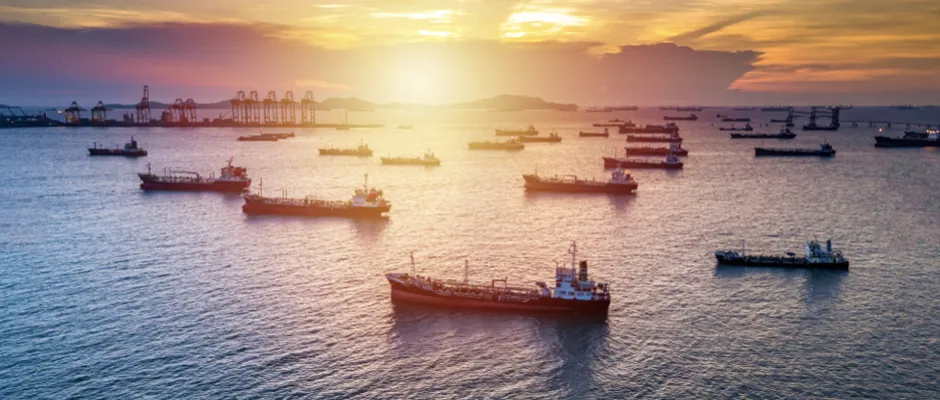LNG in Maritime Shipping: Emission Performance and Limitations in 2025
Author: Jeroen Berger • Publication date: June 22, 2025
Since the revision of MARPOL Annex VI (2021) and the phased implementation of the FuelEU Maritime Regulation (Regulation (EU) 2023/1805), liquefied natural gas (LNG) has regained attention as an alternative fuel for maritime shipping. LNG is internationally recognized as a transitional fuel: depending on engine type and combustion method, it can significantly reduce emissions of sulfur oxides (SOx), nitrogen oxides (NOx), and particulate matter (PM). Moreover, it can be deployed without fundamental modifications to existing engines, storage tanks, or bunkering infrastructure. At the same time, LNG faces structural limitations, including methane slip and limited CO2 reduction under suboptimal engine configurations.
This article outlines the factual status of LNG in 2025 in terms of emission performance, market volume, technical applicability, and legal compliance.
Emission Performance and Market Development
Since 2014, LNG has been considered one of the most technically mature alternative marine fuels, particularly in deep-sea shipping, ferry operations, and cruise services. In 2024, Shell delivered approximately 1.1 million tons of LNG for maritime applications globally, distributed across nearly 1,000 bunkering operations in 26 ports across 12 countries—doubling the volume delivered in 2023.
When combusted, LNG emits virtually no sulfur oxides (SOx), while soot formation and particulate matter emissions are also minimized. Depending on engine type, nitrogen oxide (NOx) emissions can be up to 80% lower than those of traditional HFO-fueled engines. Under ideal operating conditions, CO2 reduction reaches approximately 15–23% per ton-kilometer, influenced by engine configuration, loading factor, and operational sailing profile.
Market Share and Operational Application
Despite its emission advantages, LNG remains a niche fuel within the global bunkering industry in 2025. In Rotterdam—the Netherlands’ principal port and Europe’s largest bunkering hub—LNG accounted for approximately 3% of total bunkered volume in 2024. A total of 0.94 million m3 of LNG was delivered, representing a 52% increase compared to the previous year. In comparison, conventional fuels such as VLSFO and MGO collectively represented over 65% of market share.
Globally, the LNG-powered fleet is estimated to comprise 400 to 500 seagoing vessels, primarily operating in deep-sea container shipping, roll-on/roll-off services, and the cruise sector. Shipowners such as CMA CGM and Carnival Cruise Line utilize LNG to comply with the emission limits under MARPOL Annex VI, including the sulfur cap (Reg. 14) and the Tier III nitrogen oxide standard (Reg. 13). According to Shell’s market analysis, the number of LNG-fueled vessels could exceed 2,000 in the coming years, based on current newbuilding orders.
Limitations: Methane Slip and Well-to-Wake Emissions
A persistent concern with LNG is methane slip—the release of unburned methane (CH4) during the combustion cycle, especially in low-pressure dual-fuel engines operating on the Otto cycle. Since methane is more than 80 times more potent than CO2 as a greenhouse gas over the short term, this emission can significantly undermine LNG’s potential climate benefits.
As a result, total well-to-wake emissions of LNG are highly dependent on engine type, combustion method, and operational conditions, and do not in all cases present an improvement over conventional fuels such as HFO or MGO.
Technical Compatibility with Bio-LNG and Synthetic Methane
Despite these limitations, LNG remains a strategically deployable transitional fuel in 2025. Existing cryogenic infrastructure and engine technologies are fully compatible with bio-LNG and synthetic methane—fuels that are molecularly identical to fossil LNG and potentially climate-neutral, provided they are produced using renewable energy and certified feedstocks.
As fully drop-in alternatives, bio-LNG and synthetic methane can be applied directly within existing LNG value chains, without the need for retrofitting, engine recalibration, or modifications to onboard bunkering systems. This technical compatibility positions LNG as a scalable bridge technology toward low-emission and, ultimately, climate-neutral shipping.
Conclusie: LNG als brugtechnologie binnen de energietransitie
Between 2014 and 2025, LNG has evolved from a technological promise to a modestly adopted alternative. Despite its limited global market share, the growth in volume—including a record 1.1 million tons bunkered globally and a 52% increase in Rotterdam—demonstrates that LNG is gaining traction within specific vessel segments.
In 2025, LNG represents a practically viable pathway to emission reduction, without requiring modifications to ships or port infrastructure. Provided it is carefully applied and combined with the use of bio-LNG or synthetic methane, LNG offers a realistic stepping stone toward low-emission and eventually climate-neutral maritime shipping.


